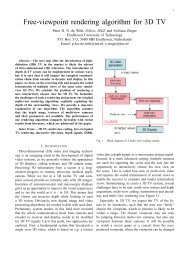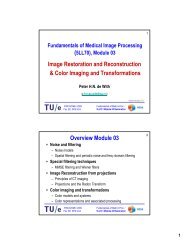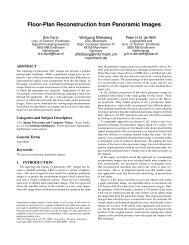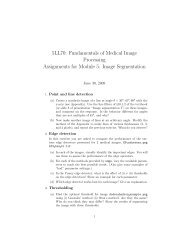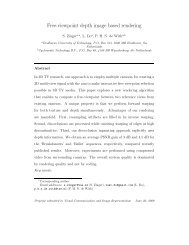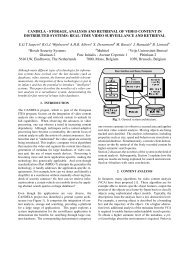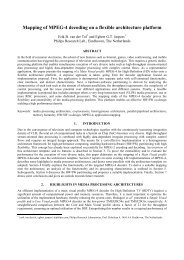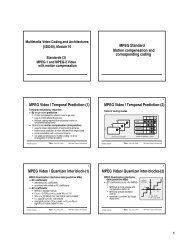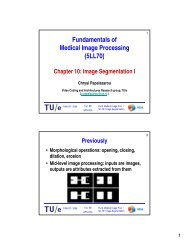System Architecture for Free-Viewpoint Video and 3D ... - IEEE Xplore
System Architecture for Free-Viewpoint Video and 3D ... - IEEE Xplore
System Architecture for Free-Viewpoint Video and 3D ... - IEEE Xplore
You also want an ePaper? Increase the reach of your titles
YUMPU automatically turns print PDFs into web optimized ePapers that Google loves.
Y. Morvan et al.: <strong>System</strong> <strong>Architecture</strong> <strong>for</strong> <strong>Free</strong>-<strong>Viewpoint</strong> <strong>Video</strong> <strong>and</strong> <strong>3D</strong>-TV 925<strong>System</strong> <strong>Architecture</strong> <strong>for</strong> <strong>Free</strong>-<strong>Viewpoint</strong> <strong>Video</strong> <strong>and</strong> <strong>3D</strong>-TVYannick Morvan, Dirk Farin <strong>and</strong> Peter H.N. de With, Fellow, <strong>IEEE</strong>Abstract — This paper presents a system architecture ofan acquisition, compression <strong>and</strong> rendering system <strong>for</strong> <strong>3D</strong>-TV <strong>and</strong> free-viewpoint video applications. We show thatthe proposed system yields two distinct advantages. First, itachieves an efficient compression of <strong>3D</strong>/multi-view videoby extending a st<strong>and</strong>ard H.264 encoder such that nearbackward compatibility is retained. Second, the proposedsystem can efficiently compress both <strong>3D</strong>-TV <strong>and</strong> freeviewpointmulti-view video datasets using the singleproposed system architecture.Index Terms — <strong>3D</strong>-TV, free viewpoint video, multi-viewvideo coding, <strong>3D</strong> video coding.I. INTRODUCTIONThe successful introduction of Blu-ray disk as a medium<strong>for</strong> distribution HDTV movies <strong>and</strong> games to the consumerestablishes, together with the increasing acceptance of largehigh-definition LCD displays, a firm basis <strong>for</strong> variousHDTV applications. In this paper, we concentrate on thenext generation of television systems, namely <strong>3D</strong>-TV. Thisinvolves the inclusion of one or more extra video signalsbesides a regular monocular video signal, such as a depthsignal <strong>and</strong>/or additional views of the same scene. Whilevarious <strong>for</strong>mats <strong>for</strong> <strong>3D</strong>-TV video signals are discussedlater, we concentrate in this paper on multi-view videoonly.A <strong>3D</strong> video is typically obtained from a set ofsynchronized cameras, which are capturing the same scenefrom different viewpoints (multi-view video). Thistechnique enables applications such as free-viewpoint video<strong>and</strong> <strong>3D</strong>-TV. First, a free-viewpoint video player providesthe ability <strong>for</strong> users to interactively navigate <strong>and</strong> select aviewpoint in the video scene. A free-viewpoint video playeris there<strong>for</strong>e similar to a <strong>3D</strong> computer graphics renderingengine, albeit based on natural images. Second, a <strong>3D</strong> ormulti-view display allows the viewer to perceive the depthof the scene. A multi-view display is a LCD panel ontowhich a lenticular sheet is accurately superimposed.1 Yannick Morvan was with the Eindhoven University of Technology,The Netherl<strong>and</strong>s. He is now with Philips Healthcare, Best, TheNetherl<strong>and</strong>s (e-mail: ymorvan@free.fr).Dirk S. Farin, was with Eindhoven University of Technology, TheNetherl<strong>and</strong>s. He is now with the Bosch Security <strong>System</strong>s Gmbh,Hilderseim, Germany (e-mail: dirk.farin@gmail.com).Peter H.N. de With is with the Eindhoven University of Technology,Eindhoven, The Netherl<strong>and</strong>s (e-mail: p.h.n.de.with@tue.nl) <strong>and</strong>CycloMedia Technology, Waardenburg, The Netherl<strong>and</strong>s.The lenticular sheet projects several views of the samescene in different directions. By observing slightly differentviews of the scene, the human brain integrates these viewsinto a <strong>3D</strong> representation of the scene. Because bothapplications rely on multiple views of the scene, bothtechnologies do not exclude each other <strong>and</strong> can beintegrated into a single <strong>3D</strong> video system. To enable <strong>3D</strong>-TVor free-viewpoint video applications, several <strong>3D</strong> videosystems have been introduced. They can be classified intothree classes with respect to the amount of employed <strong>3D</strong>geometry.A. Three dimensional video systems layoutA first class of <strong>3D</strong> video systems is based on multipletexture views of the video scene, called N-texturerepresentation <strong>for</strong>mat [1]. One advantage of the N-texturerepresentation <strong>for</strong>mat is that no <strong>3D</strong> geometric description ofthe scene is required. There<strong>for</strong>e, because <strong>3D</strong> geometry isnot used, this <strong>3D</strong> video <strong>for</strong>mat allows a simple videoprocessing chain at the encoder. However, such a <strong>3D</strong> videorepresentation <strong>for</strong>mat involves a high complexity decoder<strong>for</strong> the following reason. A multi-view display supports avarying number of views at the input, which makes itimpractical to prepare these views prior to transmission.Instead, intermediate views should be interpolated from thetransmitted reference views at the decoder where thedisplay characteristics are known. To obtain high-qualityinterpolated views, a <strong>3D</strong> geometric description of the sceneis necessary, thereby involving computationally expensivecalculations at the receiver side.A second class of <strong>3D</strong> video systems relies on a partial <strong>3D</strong>geometric description of the scene [2]. The scene geometryis typically described by a depth map, or depth image, thatspecifies the distance between a point in the <strong>3D</strong> world <strong>and</strong>the camera. Typically, a depth image is estimated from twoimages by calculating the parallax motion of pixels betweenthe views. Using depth images, new views can besubsequently rendered or synthesized using a Depth ImageBased Rendering (DIBR) algorithm. Considering a <strong>3D</strong>-TVapplication, it is assumed that the scene is observed from anarrow field of view (short baseline distance betweencameras). As a result, a combination of only one texture<strong>and</strong> one depth video sequence is sufficient to provideappropriate rendering quality (1-texture/1-depth). The 1-texture/1-depth approach was recently st<strong>and</strong>ardized by thePart 3 of the MPEG-C video specifications [3]. However,considering a video scene with rich <strong>3D</strong> geometry, renderedContributed PaperManuscript received April 15, 20080098 3063/08/$20.00 © 2008 <strong>IEEE</strong>
Y. Morvan et al.: <strong>System</strong> <strong>Architecture</strong> <strong>for</strong> <strong>Free</strong>-<strong>Viewpoint</strong> <strong>Video</strong> <strong>and</strong> <strong>3D</strong>-TV 927ACC’D’DepthestimationMulti-view <strong>3D</strong> videoacquisitionH.264 multi-viewdepth coderH.264 multi-viewtexture coderBMulti-view <strong>3D</strong> videocompressionnetworkH.264 multi-viewdepth decoderH.264 multi-viewtexture decoder<strong>3D</strong>RenderingViewsynthesisB’Multi-view <strong>3D</strong> videodecoding <strong>and</strong> rendeiringFig. 1. Overview of the proposed <strong>3D</strong> video processing system that includes (A) the acquisition of <strong>3D</strong> video (depth estimation), (B/B’)-(C/C’) the coding<strong>and</strong> decoding of the multiple texture <strong>and</strong> depth images sequences <strong>and</strong> (D) the rendering sub-system.of this approach is that disparity-compensated predictiondoes not rely on the geometry of multiple views, so thatcamera calibration parameters are not required. However,in the case that the baseline distance between cameras islarge, it has been reported [9] that a disparity-compensatedprediction scheme yields a limited coding gain overindependent coding of the individual views. An explanation<strong>for</strong> this limited per<strong>for</strong>mance is that the translational motionmodel employed by the disparity-compensated predictionscheme is not sufficiently accurate to predict the motion ofobjects with different depth.A second view-prediction scheme [4]-[22] is based on animage rendering algorithm, i.e. DIBR-based prediction. Thesynthesis algorithm employs a reference texture <strong>and</strong> depthimage as input data. The advantage of the DIBR-basedprediction is that the views can be better predicted evenwhen the baseline distance between the reference <strong>and</strong>predicted cameras is large, thereby yielding a highcompression ratio. However, as opposed to the previousapproach, the multi-camera acquisition system needs to befully calibrated prior to the capture session. Additionally, adepth image should be estimated <strong>for</strong> the central referenceview. Because estimated depth images may be inaccurate,the view-prediction quality may also be reduced.Important requirements of the view prediction algorithmare that (a) it should be robust against inaccuratelyestimated depth images, <strong>and</strong> (b) an efficient compressionshould be obtained <strong>for</strong> various baseline distances betweencameras. As discussed above, both presented viewpredictionalgorithms have their limitations <strong>and</strong> cannot beused under variable capturing conditions. There<strong>for</strong>e, ournovel strategy is to use both algorithms selectively on animage-block basis, depending on their coding per<strong>for</strong>mance.Having the outcomes of both approaches available, an a-posteriori decision is made <strong>for</strong> selection of the preferredprediction algorithm.We propose a H.264-based multi-view encoder thatemploys both prediction techniques. The most appropriateprediction technique is selected <strong>for</strong> each image blockindependently, using a rate-distortion criterion. The firstview-prediction algorithm is based on block-baseddisparity-compensated prediction. The second viewpredictiontechnique works by rendering an image as seenby the predicted camera. The algorithm is designed suchthat it is uni<strong>for</strong>m <strong>for</strong> the signal type <strong>and</strong> can h<strong>and</strong>le bothmulti-view depth <strong>and</strong> texture data in a multiplexed fashion.The remainder of this paper is organized as follows.Section II details each sub-system of the proposed <strong>3D</strong> videoprocessing system, namely depth estimation, imagerendering <strong>and</strong> multi-view video coding. Experimentalresults, which are provided in Section III, address acomparison between the prediction techniques <strong>and</strong> showrate-distortion curves of the final per<strong>for</strong>mance. The paperconcludes with Section IV.II.<strong>3D</strong> VIDEO SYSTEM ARCHITECTUREFigure 1 shows the system architecture, which iscomposed of a depth-estimation sub-system (A), a multiviewvideo coder/decoder (B/B’), a multi-view depth videocoder/decoder (C/C’) <strong>and</strong> a <strong>3D</strong>-video rendering engine (D).In the following, we address each of these sub-systems.A. Depth EstimationWe now present a method that enables the estimation ofdepth images using all views simultaneously withoutper<strong>for</strong>ming pre-preprocessing image rectification steps. Theproposed depth-estimation algorithm can be summarized asfollows. In a first step, given a selected pixel, we compute<strong>for</strong> each depth c<strong>and</strong>idate the corresponding pixel position inthe neighboring views. To compute the pixel positions inthe neighboring views, the <strong>3D</strong> position of the selected pixelis calculated using a back-projection operation [10]. Notethat this back-projection operation is based on internal <strong>and</strong>external camera parameters that indicate the location <strong>and</strong>orientation of cameras. Next, the (c<strong>and</strong>idate) pixel positionsin neighboring views are calculated by projecting the <strong>3D</strong>point onto the image planes of the neighboring cameras.There<strong>for</strong>e, by exploiting camera parameters, multiple viewscan be employed simultaneously. Because all views areemployed simultaneously, a reliable similarity value can be
930 <strong>IEEE</strong> Transactions on Consumer Electronics, Vol. 54, No. 2, MAY 2008texture video) should be decoded in parallel, involving avery high decoding computational complexity.viewstime(c)Fig. 4 Coding structure where only two central views exploit thetemporal redundancy. These two central views are then used as areference <strong>for</strong> inter-view prediction.D.Multi-view depth video codingSimilar to the compression of multi-view texture video,we propose to encode the multi-view depth video using aDIBR view-synthesis prediction algorithm. The proposeddepth-prediction technique works by synthesizing/computing the depth of <strong>3D</strong> points based on the referencedepth image [5]. As per<strong>for</strong>med <strong>for</strong> multi-view texturevideo, the depth-image prediction is also based on the relieftexture algorithm <strong>and</strong> inserted into the H.264 encoder asdescribed by Figure 3.At first glance, the multi-view texture coding <strong>and</strong> multiviewdepth coding architectures look identical. However,there is one key difference between them. In the multi-viewtexture coding case, the depth signal should be alreadyavailable to the DIBR prediction scheme. Conversely, <strong>for</strong>multi-view depth coding, the texture need not to beavailable.III. EXPERIMENTAL RESULTSFor evaluating the per<strong>for</strong>mance of the coding algorithm,experiments were carried out using the texture <strong>and</strong> depth“Ballet” <strong>and</strong> “Breakdancers” multi-view sequences. Thepresented experiments investigate the impact of the DIBRbasedprediction accuracy on the rate-distortionper<strong>for</strong>mance, using the prediction structure depicted byFigure 4. For each presented rate-distortion curve, weper<strong>for</strong>m the multi-view compression of texture <strong>and</strong> depthunder two different conditions.1. The prediction of views is carried out using onlythe block-based disparity-compensated H.264prediction.2. The prediction of views is carried out adaptivelyemploying the two-stage prediction technique(DIBR-prediction followed by disparitycompensatedprediction) from Section II-C.For coding experiments, we employed the open-sourceH.264 encoder x264 [18]. The arithmetic coding algorithmCABAC was enabled <strong>for</strong> all experiments <strong>and</strong> the motionsearch was 32 32 pixels. All predicted frames areencoded as P-frames while reference texture <strong>and</strong> depthframes are encoded as I-frames. We set the number ofreference frames to two: one reference <strong>for</strong> the block-basedmotion-prediction <strong>and</strong> a second reference <strong>for</strong> the DIBRbasedprediction. Prior to image rendering, the referencedepth is encoded with quantizer setting QP=29. Note thatdepth images should be encoded at a relatively high qualityto avoid ringing-artifacts along object borders in the depthmap. This prevents that rendering artifacts occur in theDIBR-based predicted view. This remark is similar to theconclusions related to recent depth compression results [8].A dedicated depth image coder has been recently developedby the authors to prevent these specific rendering artifacts[22]. Because depth data is necessary <strong>for</strong> <strong>3D</strong> rendering inany case, it can be assumed that depth images aretransmitted even in the case no DIBR-based prediction isemployed. Hence, employing the DIBR-based predictiondoes not involve any bit-rate overhead. It should there<strong>for</strong>ebe noted that the presented rate-distortion curves of texturevideo do not include the bit-rate of depth images.Let us now discuss the obtained rate-distortion curves <strong>for</strong>multi-view texture coding of Figure 5 <strong>and</strong> Figure 6. First, itcan be observed that the proposed DIBR-based predictionalgorithm consistently outper<strong>for</strong>ms the block-baseddisparity-compensated prediction scheme. For example,considering Figure 5, the DIBR-based prediction algorithmyields a quality improvement of up to 1 dB at 200 kbit/s<strong>and</strong> 0.4 dB at 400 kbit/s over the block-based disparitycompensatedprediction algorithm. Considering Figure 6,PSNR (dB)4140393837363534disparity-compensatedpredictiondisparity-compensated <strong>and</strong>DIBR prediction33200 400 600 800 1000 1200 1400 1600 1800Bit rate (kbit/s)Fig. 5 Rate-Distortion curves of the multi-view texture sequence“Breakdancers”.PSNR (dB)4140393837363534disparity-compensatedpredictiondisparity-compensated <strong>and</strong>DIBR prediction33200 400 600 800 1000 1200 1400 1600 1800Bit rate (kbit/s)Fig. 6 Rate-Distortion curves of the multi-view texture sequence“Ballet”.
932 <strong>IEEE</strong> Transactions on Consumer Electronics, Vol. 54, No. 2, MAY 2008[2] C. Fehn "Depth-Image-Based Rendering (DIBR), Compression <strong>and</strong>Transmission <strong>for</strong> a New Approach on <strong>3D</strong>-TV" In Proceedings ofSPIE Stereoscopic Displays <strong>and</strong> Virtual Reality <strong>System</strong>s XI, pp 93–104, San Jose, CA, USA, January 2004.[3] “Applications <strong>and</strong> Requirements <strong>for</strong> StereoScopic <strong>Video</strong> (SSV)”ISO/IEC JTC1/SC29/WG11 Bangkok, Thail<strong>and</strong>, January 2006.[4] C. L. Zitnick, S. B. Kang, M. Uyttendaele, S. A. J. Winder <strong>and</strong> R.Szeliski "High-quality <strong>Video</strong> View Interpolation Using a LayeredRepresentation", ACM Transactions on Graphics (TOG)SIGGRAPH, Vol. 23, Issue 3, pp 600–608, August 2004.[5] Y. Morvan,, D. Farin, P. H.N. de With ”Predictive coding of depthimages across multiple views” in Proceedings of SPIE, StereoscopicDisplays <strong>and</strong> Applications, Vol. 6490, January 2007, San Jose, USA.[6] Y. Morvan, D. Farin, P. H.N. de With “Incorporating depth-imagebased view-prediction into H.264 <strong>for</strong> multiview-image coding” in<strong>IEEE</strong> International Conference on Image Processing (ICIP), Vol. I,pp 205–208, September 2007, San Antonio, USA.[7] D. Scharstein <strong>and</strong> R. Szeliski “A taxonomy <strong>and</strong> evaluation of densetwo-frame stereo correspondence algorithms” International Journalof Computer Vision, Vol. 47(1/2/3), pages 7–42, April-June 2002.[8] P. Kauff <strong>and</strong> N. Atzpadin <strong>and</strong> C. Fehn <strong>and</strong> M. Mueller <strong>and</strong> O.Schreer <strong>and</strong> A. Smolic <strong>and</strong> R. Tanger, “Depth map creation <strong>and</strong>image-based rendering <strong>for</strong> advanced <strong>3D</strong>TV services providinginteroperability <strong>and</strong> scalability”, in Signal Processing: ImageCommunication, Vol. 22, no.2, pp. 217–234, 2007.[9] P. Merkle, K. Mueller, A. Smolic, <strong>and</strong> T. Wieg<strong>and</strong>, “Efficientcompression of multi-view video exploiting inter-view dependenciesbased on H.264/MPEG4-AVC,” in <strong>IEEE</strong> International Conferenceon Multimedia <strong>and</strong> Expo (ICME 2006), Vol. 1, pp. 1717–1720,Toronto, Canada, 2006.[10] R. Hartley <strong>and</strong> A. Zisserman “Multiple View Geometry in ComputerVision” Cambridge University Press, 2004.[11] Aaron F. Bobick <strong>and</strong> Stephen S. Intille, “Large occlusion stereo”,International Journal of Computer Vision, Vol. 33, no. 3, pp. 181–200, 1999,[12] L. McMillan “An Image-Based Approach to Three-DimensionalComputer Graphics” Ph.D. thesis University of North Carolina, April1997.[13] Manuel M. Oliveira, “Relief Texture Mapping”, Ph.D. thesis,University of North Carolina, March 2000.[14] G. Wolberg “Digital Image Warping” <strong>IEEE</strong> Computer Society Press,July 1990.[15] Y. Morvan, D. Farin, <strong>and</strong> P. H. N. de With, “Design considerations<strong>for</strong> view interpolation in a <strong>3D</strong> video coding” 27th Symposium onIn<strong>for</strong>mation Theory in the Benelux, 2006.[16] P. E. Debevec, Y. Yu <strong>and</strong> G. D. Borshukov "Efficient viewdependentimage-based rendering with projective texture mapping"Eurographics Rendering Workshop 1998, pp 105–116, June 1998,Vienna, Austria.[17] “MPEG document, Survey of algorithms used <strong>for</strong> Multi-View <strong>Video</strong>Coding (MVC).” ISO/IEC JTC1/SC29/WG11, MPEG2005/N6909,January 2005.[18] Webpage title: x264 a free H.264/AVC encoder,http://www.videolan.org/developers/x264.html, last visited: April2008.[19] C. Fehn, N. Atzpadin, M. Müller, O. Schreer, A. Smolic, R. Tanger,<strong>and</strong> P. Kauff, “An advanced <strong>3D</strong>TV concept providinginteroperabilty <strong>and</strong> scalabilty <strong>for</strong> a wide range of multi-baselinegeometries” in <strong>IEEE</strong> International Conference on Image Processing,Atlanta, USA, October 2006.[20] Y. Morvan, P. H.N. de With, <strong>and</strong> D. Farin, “Platelet-based coding ofdepth maps <strong>for</strong> the transmission of multiview images”, inStereoscopic Displays <strong>and</strong> Applications XVII, Proceedings of theSPIE, 2006.[21] Y. Morvan, D. Farin, <strong>and</strong> P. H. N. de With, “Design considerations<strong>for</strong> a <strong>3D</strong>-TV architecture” in <strong>IEEE</strong> International Conference onConsumer Electronics, Las Vegas, USA, January 2008.Y. Morvan,D. Farin, <strong>and</strong> P. H. N. de With, “Depth-Image Compression based onan R-D Optimized Quadtree Decomposition <strong>for</strong> the Transmission ofMultiview Images” in <strong>IEEE</strong> International Conference on ImageProcessing (ICIP), pp 205–208, San Antonio, USA, Sept. 2007.[22] E. Martinian <strong>and</strong> A. Behrens <strong>and</strong> J. Xin <strong>and</strong> A. Vetro, “ViewSynthesis <strong>for</strong> Multiview <strong>Video</strong> Compression” in Picture CodingSymposium, Beijing, China,. April 2006.Yannick Morvan received his M.S. in ElectricalEngineering from the Institut Supérieur d'Electroniqueet du Numérique (ISEN), France in 2003. During hisundergraduate studies, he worked, in 2002, at PhilipsResearch on embedded image processing software<strong>and</strong>, in 2003, at Philips Medical <strong>System</strong>s on X-rayimage quality enhancement algorithms. In 2004, hejoined, as a Ph.D. c<strong>and</strong>idate, the <strong>Video</strong> Coding <strong>and</strong> <strong>Architecture</strong>s researchgroup at the Eindhoven University of Technology, The Netherl<strong>and</strong>s.During his Ph.D. project, he was involved in a joint project of PhilipsResearch <strong>and</strong> the Eindhoven University of Technology about thedevelopment of a multi-camera video acquisition <strong>and</strong> compression system<strong>for</strong> 3-D television. In 2006, he co-organized with Philips Research the“<strong>IEEE</strong> workshop on Content Generation <strong>and</strong> Coding <strong>for</strong> <strong>3D</strong>-television”.His research interests include multi-view coding, <strong>3D</strong> reconstruction <strong>and</strong>image rendering. One of his papers on multi-view coding was a Best PaperFinalist at the 2007 Picture Coding Symposium in Lisbon, Portugal. In2008, Yannick Morvan became imaging scientist at Philips Healthcare,Best, The Netherl<strong>and</strong>s.Dirk Farin graduated in computer science <strong>and</strong>electrical engineering from the University of Stuttgart,Germany. In 1999, he became research assistant at theDepartment of Circuitry <strong>and</strong> Simulation at theUniversity of Mannheim. He joined the Department ofComputer Science IV at the University of Mannheimin 2001 <strong>and</strong> the VCA group at the University ofTechnology Eindhoven in 2004. In 2005, he received his Ph.D. degreefrom the University of Technology Eindhoven, Netherl<strong>and</strong>s. He received abest student paper award at the SPIE Visual Communications <strong>and</strong> ImageProcessing conference in 2004 <strong>for</strong> his work on multi-sprites, <strong>and</strong> two beststudent paper awards at the Symposium on In<strong>for</strong>mation Theory in theBenelux in 2001 <strong>and</strong> 2003. His research interests include video-objectsegmentation, video compression, content analysis, <strong>and</strong> 3-Dreconstruction. In 2005, he organized a special session about sports-videoanalysis at the <strong>IEEE</strong> International Conference on Multimedia <strong>and</strong> Expo. In2008, Dirk Farin became scientist at Robert Bosch Security <strong>System</strong>,Hildesheim, Germany.Peter H.N. de With, <strong>IEEE</strong> Fellow, obtained his MSc.in electrical engineering from the EindhovenUniversity of Technology, <strong>and</strong> his PhD. From DelftUniversity of Technology, The Netherl<strong>and</strong>s. Hejoined Philips Research Labs Eindhoven in 1984,where he worked on video coding <strong>for</strong> digitalrecording. From 1985 to 1993, he was involved inseveral European projects on SDTV <strong>and</strong> HDTV recording. In this period,he contributed as a principal coding expert to the DV st<strong>and</strong>ardization <strong>for</strong>digital camcording. Between 1994 <strong>and</strong> 1997 he was leading the design ofadvanced programmable video architectures at the same lab. In 1996, hebecame senior TV systems architect <strong>and</strong> in 1997, he was appointed as fullprofessor at the University of Mannheim, Germany, at the facultyComputer Engineering. In Mannheim he was heading the chair on DigitalCircuitry <strong>and</strong> Simulation with the emphasis on video systems. Between2000 <strong>and</strong> 2007, he was with LogicaCMG in Eindhoven as a principalconsultant <strong>and</strong> also professor at the Eindhoven University of Technology,at the faculty of Electrical Engineering. He is now with CycloMediaTechnology, The Netherl<strong>and</strong>s. He has written <strong>and</strong> coauthored over 200papers on video coding, architectures <strong>and</strong> their realization. Regularly, he isa teacher of the Philips Technical Training <strong>and</strong> <strong>for</strong> other post-academiccourses. In 1995 <strong>and</strong> 2000, he coauthored papers that received the <strong>IEEE</strong>CES Transactions Paper Award, <strong>and</strong> in 2004, the VCIP Best Paper Award.In 1996, he obtained a company Invention Award. Mr. de With is <strong>IEEE</strong>Fellow, advisor to Philips, scientific advisor of the Dutch Imaging schoolASCII, <strong>IEEE</strong> ISCE <strong>and</strong> board member of various working groups.



